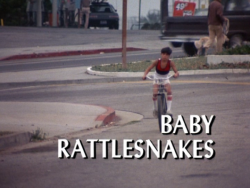Baby Rattlesnakes (Quincy, M.E.)
| Baby Rattlesnakes | ||||||||||||||||||||||||||||||||||||||
|---|---|---|---|---|---|---|---|---|---|---|---|---|---|---|---|---|---|---|---|---|---|---|---|---|---|---|---|---|---|---|---|---|---|---|---|---|---|---|

| ||||||||||||||||||||||||||||||||||||||
|
Episode Quote
“Those babies are lethal killers. Ethan Kellogg did not kill that child.” ~ Dr. Emily Hanover, defending her program’s youth
Episode Overview
Baby Rattlesnakes is the premiere episode of Season 7 of *Quincy, M.E.*, originally aired on NBC on September 29, 1982. In this episode, Quincy investigates the death of a nine‑year‑old girl killed in a drive‑by shooting. A 14‑year‑old probation‑program participant, Ethan Kellogg, is suspected. Quincy teams up with Dr. Emily Hanover, a psychologist introduced in this episode, to uncover the truth and test the effectiveness of juvenile rehabilitation programs
Table of Contents
Application of The QME Episode Laws
✅ Law 1: Seek truth & justice for the victim Quincy refuses to accept the arrest of Ethan Kellogg without thorough forensic investigation into the drive‑by shooting
✅ Law 2: Highlight social & ethical issues The episode tackles juvenile crime, gang violence, and juvenile justice programs, framing a debate over rehabilitation vs punitive justice
✅ Law 3: Sensitive treatment of complex topics Through its focus on youth offenders and victim impact, the episode explores controversial issues of juvenile culpability with nuance.
✅ Law 4: Forensic accuracy Quincy’s autopsy techniques and evidence assessment (shell casing, trajectory, forensic psychology) underscore the show’s scientific integrity
Episode Synopsis
Dr. Quincy conducts an autopsy on a nine‑year‑old girl shot in a drive‑by while outside her home. Investigators quickly detain Ethan Kellogg, aged 14, a participant in a juvenile probation/gang‑exit program run by Dr. Emily Hanover and probation officer Rick Durado. Ethan claims innocence. Quincy’s forensic analysis of bullet trajectory and gun residue suggests Ethan didn’t fire the fatal shot. Quincy is convinced, but must collaborate with Hanover, whose faith in her program conflicts with official suspicion. Quincy and Hanover race to prove Ethan was framed by true assailants or protect the program’s funding. They face political pressure and skepticism. Ultimately, forensic evidence—ballistics and witness corroboration—exonerates Ethan and keeps the juvenile program alive.
Plot Summary
- Quincy performs the autopsy and discovers forensic inconsistencies.
- Ethan is arrested; Quincy suggests more investigation
- Quincy meets Dr. Hanover and probation officers; tension arises between forensic caution and program advocacy
- Evidence review shows shell casings unfamiliar to Ethan’s weapon; labeled him innocent.
- Political pressure mounts as a juvenile‑justice champion threatens to close the program.
- Quincy uncovers alibi witnesses and corroborating forensic data.
- The episode concludes with Ethan’s exoneration and Quincy advocating community‑based solutions.
← Season 7 Finale • Baby Rattlesnakes • S08E02: “Ghost of a Chance” Season 8 Overview: Full Episode List
Main Cast
- Jack Klugman as Dr. R. Quincy
- Robert Ito as Sam Fujiyama
- Garry Walberg as Lt. Monahan
- John S. Ragin as Dr. Asten
Guest Cast
- Anita Gillette as Dr. Emily Hanover
- Gregory Sierra as Rick Durado
- John Randolph as unnamed politician
- De'Voreaux White as Ethan Kellogg
- Additional supporting cast :contentReference[oaicite:8]{index=8}
Case File Summary
Victim: nine‑year‑old girl (name unrevealed) Suspect initially arrested: Ethan Kellogg (14, probation program) Case outcome: Innocence proven; lead evidence points to gang‑affiliated shooters targeting program participants
Filming Locations
Location details unspecified in available sources; production likely used Los Angeles soundstage and exteriors consistent with series format.
Forensic Science Insight
- Autopsy demonstrates trajectory analysis and GSR to exonerate suspect
- Quincy interviews bystanders to corroborate ballistic evidence
- Demonstrates forensic psychology’s role in juvenile cases
- Highlights systemic pressures influencing forensic objectivity
Themes & Tropes
- Forensic Science as Justice – Quincy as a scientifically driven crusader
- Youth Crime & Rehabilitation – Societal struggle with juvenile justice
- Institutional Pressure – Funding and politics vs impartial investigation
Reception & Ratings
- IMDb rates the episode 6.6/10 based on ~1,080 user reviews :contentReference[oaicite:9]{index=9}
- “Baby Rattlesnakes begins with a young girl being killed … Quincy becomes interested in learning more about their techniques as well as Dr. Hannover.” — rayoflite24 :contentReference[oaicite:10]{index=10}
- Critics note its socially conscious focus, though some felt tone became preachy :contentReference[oaicite:11]{index=11}
Trivia
- First appearance of Dr. Emily Hanover (Anita Gillette), who becomes Quincy’s future wife; coincidentally, Gillette earlier played Quincy’s dead wife :contentReference[oaicite:12]{index=12}.
- Episode title metaphorically references “baby rattlesnakes”—young offenders molded by gang culture :contentReference[oaicite:13]{index=13}.
Cultural Impact
Episode continues Quincy’s tradition of blending forensic investigation with social advocacy. Its focus on juvenile justice prefigured later public discourse and influenced crime dramas addressing systemic issues.
See Also
References
External Links
- [IMDb page for “Baby Rattlesnakes”] – *Baby Rattlesnakes* (1982) at IMDb :contentReference[oaicite:14]{index=14}
- Transcript at SubsLikeScript :contentReference[oaicite:15]{index=15}
